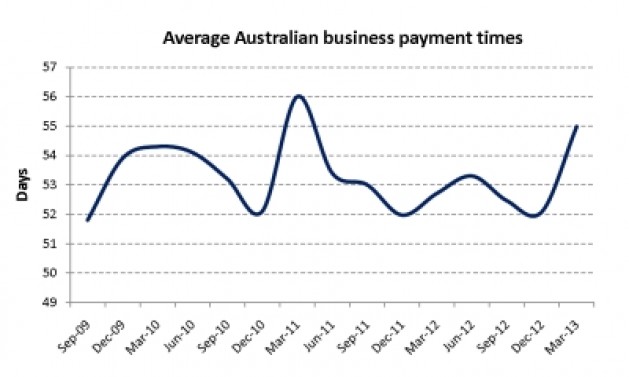
Business cash flow has slowed this year, placing further strain on a range of industries already experiencing low confidence because of weak trading activity and high operating costs.
Businesses are waiting nearly eight weeks to be paid by other companies according to Dun & Bradstreet’s latest Trade Payments Analysis, with the average invoice payment time rising to 55 days during the first quarter of 2013. This figure compares to a national average of 52 days in the previous quarter and 53 days a year earlier, while in New Zealand the average payment time is at 43 days.
After easing during the last half of 2012, payment times have increased this year as a combination of weak sales activity, a high Australian dollar and concerns about operating costs affect businesses’ ability to pay on time. Operational costs were identified as the biggest barrier to growth for businesses in the quarter ahead according to the latest D&B Business Expectations Survey.
The slow payment cycle, as revealed by analysis of millions of accounts-receivables records, is being felt by the nation’s businesses, with D&B finding that 56 per cent of businesses expect cash flow will be an issue for their operations in the quarter ahead.
D&B’s analysis has also found that the nation’s biggest companies are the slowest to pay, with those companies employing more than 500 employees taking 58 days to settle their accounts in Q1.
The majority of all invoice payments in Australia are being paid late, with 48 per cent of accounts settled between one and 30 days beyond standard payment terms (30 days), while 38 per cent are made on time.
“The state of late payments in Australia is a handbrake on business activity at a time when greater investment and productivity is needed,” said Gareth Jones, Dun & Bradstreet’s CEO.
“While we’re seeing more positive signs for consumers, in terms of a strong sharemarket, rebounding house prices and lower debt balances, businesses expectations remain low,” he said.
“In this environment, a slowing cash flow cycle further hits businesses. Their ability to spend money and invest in the growth of their business, and by consequence the economy, is limited when they’re kept waiting for payments.
“More significantly, however, is if late payments are impacting a business’s ability to cover its own costs of operation. We know that 90 per cent of small businesses failures are caused by poor cash flow,” Mr Jones warned.
Reflecting the importance of cash flow to smaller businesses, the Trade Payments Analysis shows that companies employing fewer staff are generally making their payments more quickly than larger businesses.
Companies with fewer than 20 staff are taking on average 53 days for payments, whereas those employing more than 500 people average more than 57 days to pay their bills. The fastest paying companies, however, are medium-sized operations employing between 50 and 199 people, which are settling their accounts in 50 days.
All industries experienced slower payment times compared to the previous quarter, with the forestry sector the slowest to pay their bills, at 69 days.
Businesses from the mining, utilities, and retail sectors were the next slowest to make payments, increasing from 55 days to 57 days for Q1 2013.
“The rise in average payment times fits with the broad themes that have been unfolding elsewhere in the economy recently,” said Stephen Koukoulas, economic advisor to Dun & Bradstreet.
“We are seeing slower economic growth, soft business confidence and, as we saw in this month’s Business Expectations Survey, a clear weakening in business investment plans, hiring intentions and expected selling prices,” he said.
“The recent cuts to interest rates will, in time, help with firms’ cash flows but a lift in economic activity is also needed to see payment times fall back to more comfortable levels.
“The recent fall in the Australian dollar, if it is sustained, might help parts of local industry, but that will take time.
“The increase in average payment times is another reason why the Reserve Bank is likely to deliver at least one more interest rate cut in the months ahead. For firms with debt, a further interest rate cut would help free up cash and contribute to improved payment times,” Mr Koukoulas noted.





